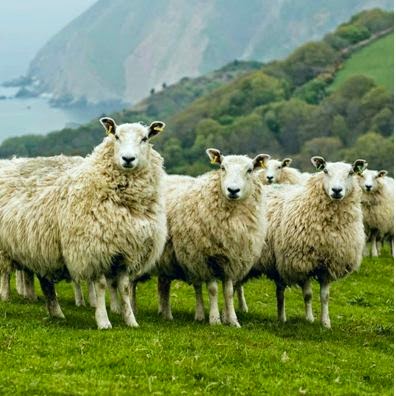Polypay
[polypay sheep]
This is a "modern" dual-purpose breed of sheep, developed in the US in the 1970's. It's a mix of Finnsheep, Dorset, Rambouillet, and Targhee. The roving I got was from a lamb (ie. its first clip!) and therefore probably finer than what an adult sheep would provide, although Polypay sheep are bred to produce "fine" wool. It's commercially combed top, very springy, and reminds me of Southdown - but much finer. It's quite easy to spin. I did a 4-ply cable ply because I'm not convinced that this very fine fiber is going to be as long-lasting as some of the coarser fibers I've been spinning.The resulting yarn is soft, elastic, and very poofy. Now that I'm done with it, I think it's not suitable for socks, it's just so soft! Perhaps adult polypay fleece is stronger, but this is not going to be knit into socks! In fact, I knit a shawl with it, which turned out "meh" - didn't drape as well as I'd like. Very soft, but because of the boing factor, probably best suited to hats, mittens, and casual sweaters.
[ polypay lamb fingering, 4-ply cable-ply ]
Exmoor Blueface
[exmoor blueface sheep]
This fiber I got from my favourite Etsy shop in the UK and is also available here. The sheep - called "mules" - are from an Exmoor Horn ewe and a BFL sire (read my post on sheep breeding for more about mules), and they come from the Exmoor area in Britain (which isn't very big), in the bottom left hand corner of the country. The Exmoor area been part of the wool trade for centuries, with a variety of breeds (Exmoor, Dartmoor and Cheviot) grazing the "moors" or high, treeless hills. I looked up Exmoor Horn sheep in my copy of The Fleece and Fiber Sourcebook, and it appears these are meat sheep, not really known for their fiber. What I got is long-stapled and not as crimpy as the downs breeds, although much curlier and crisper than the Border Leceister and BFL I've tried. It's not as fine as BFL, so I'm thinking it'll be harder wearing. The yarn is definitely more elastic than the Border Leceister - and also the BFL- but not as springy as Southdown. So far the socks are knitting up very nicely, they are cushy and elastic. I'm really liking this. Definitely a breed to add to the sock repertoire!
[ exmoor blueface sock yarn, 4-ply cable-ply ]
I've been able to get my hands on some 40/60 Exmoor Blueface / Zwartbles blend (thank you HilltopCloud!) and this has also been very nice to work with. This is a bit coarser and tougher than the Exmoor Blueface above, but it makes lovely hiking socks. Again, something to add to the repertoire.
[ exmoor blueface / zwartbles blend socks, 3-ply chained ]
So far, I've been enjoying my experiments with these dual-purpose breed fibres. It's very elastic "out of the box" and I really enjoy knitting with it. I've not been successful in getting dress-sock grist with this stuff yet (still trying!) but the hiking socks I've knit up feel indestructible!
**update** the Exmoor/Zwartbles blend (I've used this 2x now, still loving how it spins and knits up!) is prone to felting. It's probably best hand-washed. Sadly, since I refuse to handwash laundry items (maybe in my retirement I will find the time for this activity?), this blend is going to have to come off my list of useful sock fibers...
So far, I've been enjoying my experiments with these dual-purpose breed fibres. It's very elastic "out of the box" and I really enjoy knitting with it. I've not been successful in getting dress-sock grist with this stuff yet (still trying!) but the hiking socks I've knit up feel indestructible!
**update** the Exmoor/Zwartbles blend (I've used this 2x now, still loving how it spins and knits up!) is prone to felting. It's probably best hand-washed. Sadly, since I refuse to handwash laundry items (maybe in my retirement I will find the time for this activity?), this blend is going to have to come off my list of useful sock fibers...





No comments:
Post a Comment